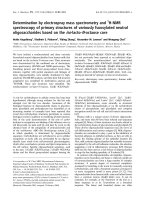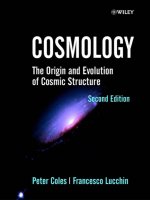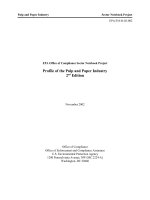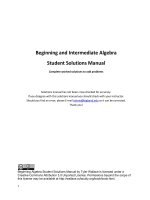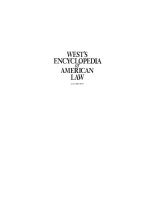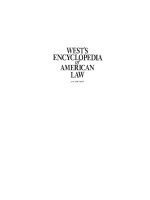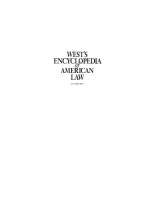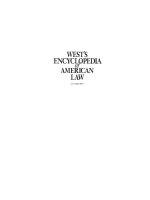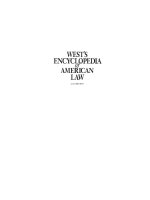cosmology the origin and evolution of cosmic structure, 2nd edition the origin and evolution of cosmic structure
Bạn đang xem bản rút gọn của tài liệu. Xem và tải ngay bản đầy đủ của tài liệu tại đây (3.38 MB, 515 trang )
Cosmology
The Origin and Evolution
of Cosmic Structure
Second Edition
Peter Coles
School of Physics & Astronomy,
University of Nottingham, UK
Francesco Lucchin
Dipartimento di Astronomia,
Università di Padova, Italy
Cosmology
The Origin and Evolution
of Cosmic Structure
Cosmology
The Origin and Evolution
of Cosmic Structure
Second Edition
Peter Coles
School of Physics & Astronomy,
University of Nottingham, UK
Francesco Lucchin
Dipartimento di Astronomia,
Università di Padova, Italy
Copyright © 2002 John Wiley & Sons, Ltd
Baffins Lane, Chichester,
West Sussex PO19 1UD, England
National 01243 779777
International (+44) 1243 779777
e-mail (for orders and customer service enquiries):
Visit our Home Page on or
All Rights Reserved. No part of this publication may be reproduced, stored in a retrieval
system, or transmitted, in any form or by any means, electronic, mechanical, photocopying,
recording, scanning or otherwise, except under the terms of the Copyright, Designs and
Patents Act 1988 or under the terms of a licence issued by the Copyright Licensing Agency
Ltd, 90 Tottenham Court Road, London, UK W1P 0LP, without the permission in writing of
the Publisher with the exception of any material supplied specifically for the purpose of
being entered and executed on a computer system for exclusive use by the purchaser of
the publication.
Neither the author nor John Wiley & Sons, Ltd accept any responsibility or liability for loss
or damage occasioned to any person or property through using the material, instructions,
methods or ideas contained herein, or acting or refraining from acting as a result of such
use. The author and publisher expressly disclaim all implied warranties, including mer-
chantability or fitness for any particular purpose. There will be no duty on the author or
publisher to correct any errors or defects in the software.
Designations used by companies to distinguish their products are often claimed as trade-
marks. In all instances where John Wiley & Sons, Ltd is aware of a claim, the product names
appear in capital or all capital letters. Readers, however, should contact the appropriate
companies for more complete information regarding trademarks and registration.
Library of Congress Cataloging-in-Publication Data
(applied for)
British Library Cataloguing in Publication Data
A catalogue record for this book is available from the British Library
ISBN 0 471 48909 3
Typeset in 9.5/12.5pt Lucida Bright by T
&
T Productions Ltd, London.
Printed and bound in Great Britain by Antony Rowe Ltd., Chippenham, Wilts.
This book is printed on acid-free paper responsibly manufactured from sustainable
forestry in which at least two trees are planted for each one used for paper production.
Contents
Preface to First Edition xi
Preface to Second Edition xix
PART 1 Cosmological Models 1
1 First Principles 3
1.1 The Cosmological Principle 3
1.2 Fundamentals of General Relativity 6
1.3 The Robertson–Walker Metric 9
1.4 The Hubble Law 13
1.5 Redshift 1
1.6 The Deceleration Parameter 17
1.7 Cosmological Distances 18
1.8 The m–z and N–z Relations 20
1.9 Olbers’ Paradox 22
1.10 The Friedmann Equations 23
1.11 A Newtonian Approach 24
1.12 The Cosmological Constant 26
1.13 Friedmann Models 29
2 The Friedmann Models 33
2.1 Perfect Fluid Models 33
2.2 Flat Models 36
2.3 Curved Models: General Properties 38
2.3.1 Open models 39
2.3.2 Closed models 40
2.4 Dust Models 40
2.4.1 Open models 41
2.4.2 Closed models 41
2.4.3 General properties 42
2.5 Radiative Models 43
2.5.1 Open models 43
2.5.2 Closed models 44
2.5.3 General properties 44
2.6 Evolution of the Density Parameter 44
2.7 Cosmological Horizons 45
2.8 Models with a Cosmological Constant 49
5
vi Contents
3 Alternative Cosmologies 51
3.1 Anisotropic and Inhomogeneous Cosmologies 52
3.1.1 The Bianchi models 52
3.1.2 Inhomogeneous models 55
3.2 The Steady-State Model 57
3.3 The Dirac Theory 59
3.4 Brans–Dicke Theory 61
3.5 Variable Constants 63
3.6 Hoyle–Narlikar (Conformal) Gravity 64
4 Observational Properties of the Universe 67
4.1 Introduction 67
4.1.1 Units 67
4.1.2 Galaxies 69
4.1.3 Active galaxies and quasars 70
4.1.4 Galaxy clustering 72
4.2 The Hubble Constant 75
4.3 The Distance Ladder 79
4.4 The Age of the Universe 83
4.4.1 Theory 83
4.4.2 Stellar and galactic ages 84
4.4.3 Nucleocosmochronology 84
4.5 The Density of the Universe 86
4.5.1 Contributions to the density parameter 86
4.5.2 Galaxies 88
4.5.3 Clusters of galaxies 89
4.6 Deviations from the Hubble Expansion 92
4.7 Classical Cosmology 94
4.7.1 Standard candles 95
4.7.2 Angular sizes 97
4.7.3 Number-counts 99
4.7.4 Summary 100
4.8 The Cosmic Microwave Background 100
PART 2 The Hot Big Bang Model 107
5 Thermal History of the Hot Big Bang Model 109
5.1 The Standard Hot Big Bang 109
5.2 Recombination and Decoupling 111
5.3 Matter–Radiation Equivalence 112
5.4 Thermal History of the Universe 113
5.5 Radiation Entropy per Baryon 115
5.6 Timescales in the Standard Model 116
6 The Very Early Universe 119
6.1 The Big Bang Singularity 119
6.2 The Planck Time 122
6.3 The Planck Era 123
6.4 Quantum Cosmology 126
6.5 String Cosmology 128
7 Phase Transitions and Inflation 131
7.1 The Hot Big Bang 131
7.2 Fundamental Interactions 133
7.3 Physics of Phase Transitions 136
7.4 Cosmological Phase Transitions 138
Contents vii
7.5 Problems of the Standard Model 141
7.6 The Monopole Problem 143
7.7 The Cosmological Constant Problem 145
7.8 The Cosmological Horizon Problem 147
7.8.1 The problem 147
7.8.2 The inflationary solution 149
7.9 The Cosmological Flatness Problem 152
7.9.1 The problem 152
7.9.2 The inflationary solution 154
7.10 The Inflationary Universe 156
7.11 Types of Inflation 160
7.11.1 Old inflation 160
7.11.2 New inflation 161
7.11.3 Chaotic inflation 161
7.11.4 Stochastic inflation 162
7.11.5 Open inflation 162
7.11.6 Other models 163
7.12 Successes and Problems of Inflation 163
7.13 The Anthropic Cosmological Principle 164
8 The Lepton Era 167
8.1 The Quark–Hadron Transition 167
8.2 Chemical Potentials 168
8.3 The Lepton Era 171
8.4 Neutrino Decoupling 172
8.5 The Cosmic Neutrino Background 173
8.6 Cosmological Nucleosynthesis 176
8.6.1 General considerations 176
8.6.2 The standard nucleosynthesis model 177
8.6.3 The neutron–proton ratio 178
8.6.4 Nucleosynthesis of Helium 179
8.6.5 Other elements 181
8.6.6 Observations: Helium 4 182
8.6.7 Observations: Deuterium 183
8.6.8 Helium 3 184
8.6.9 Lithium 7 185
8.6.10 Observations versus theory 185
8.7 Non-standard Nucleosynthesis 186
9 The Plasma Era 191
9.1 The Radiative Era 191
9.2 The Plasma Epoch 192
9.3 Hydrogen Recombination 194
9.4 The Matter Era 195
9.5 Evolution of the CMB Spectrum 197
PART 3 Theory of Structure Formation 203
10 Introduction to Jeans Theory 205
10.1 Gravitational Instability 205
10.2 Jeans Theory for Collisional Fluids 206
10.3 Jeans Instability in Collisionless Fluids 210
10.4 History of Jeans Theory in Cosmology 212
10.5 The Effect of Expansion: an Approximate Analysis 213
10.6 Newtonian Theory in a Dust Universe 215
10.7 Solutions for the Flat Dust Case 218
10.8 The Growth Factor 219
viii Contents
10.9 Solution for Radiation-Dominated Universes 221
10.10 The Method of Autosolution 223
10.11 The Meszaros Effect 225
10.12 Relativistic Solutions 227
11 Gravitational Instability of Baryonic Matter 229
11.1 Introduction 229
11.2 Adiabatic and Isothermal Perturbations 230
11.3 Evolution of the Sound Speed and Jeans Mass 231
11.4 Evolution of the Horizon Mass 233
11.5 Dissipation of Acoustic Waves 234
11.6 Dissipation of Adiabatic Perturbations 237
11.7 Radiation Drag 240
11.8 A Two-Fluid Model 241
11.9 The Kinetic Approach 244
11.10 Summary 248
12 Non-baryonic Matter 251
12.1 Introduction 251
12.2 The Boltzmann Equation for Cosmic Relics 252
12.3 Hot Thermal Relics 253
12.4 Cold Thermal Relics 255
12.5 The Jeans Mass 256
12.6 Implications 259
12.6.1 Hot Dark Matter 260
12.6.2 Cold Dark Matter 261
12.6.3 Summary 262
13 Cosmological Perturbations 263
13.1 Introduction 263
13.2 The Perturbation Spectrum 264
13.3 The Mass Variance 266
13.3.1 Mass scales and filtering 266
13.3.2 Properties of the filtered field 268
13.3.3 Problems with filters 270
13.4 Types of Primordial Spectra 271
13.5 Spectra at Horizon Crossing 275
13.6 Fluctuations from Inflation 276
13.7 Gaussian Density Perturbations 279
13.8 Covariance Functions 281
13.9 Non-Gaussian Fluctuations? 284
14 Nonlinear Evolution 287
14.1 The Spherical ‘Top-Hat’ Collapse 287
14.2 The Zel’dovich Approximation 290
14.3 The Adhesion Model 294
14.4 Self-similar Evolution 296
14.4.1 A simple model 296
14.4.2 Stable clustering 299
14.4.3 Scaling of the power spectrum 300
14.4.4 Comments 301
14.5 The Mass Function 301
14.6 N-Body Simulations 304
14.6.1 Direct summation 305
14.6.2 Particle–mesh techniques 306
14.6.3 Tree codes 309
14.6.4 Initial conditions and boundary effects 309
Contents ix
14.7 Gas Physics 310
14.7.1 Cooling 310
14.7.2 Numerical hydrodynamics 312
14.8 Biased Galaxy Formation 314
14.9 Galaxy Formation 318
14.10 Comments 321
15 Models of Structure Formation 323
15.1 Introduction 323
15.2 Historical Prelude 324
15.3 Gravitational Instability in Brief 326
15.4 Primordial Density Fluctuations 327
15.5 The Transfer Function 328
15.6 Beyond Linear Theory 330
15.7 Recipes for Structure Formation 331
15.8 Comments 334
PART 4 Observational Tests 335
16 Statistics of Galaxy Clustering 337
16.1 Introduction 337
16.2 Correlation Functions 339
16.3 The Limber Equation 342
16.4 Correlation Functions: Results 344
16.4.1 Two-point correlations 344
16.5 The Hierarchical Model 346
16.5.1 Comments 348
16.6 Cluster Correlations and Biasing 350
16.7 Counts in Cells 352
16.8 The Power Spectrum 355
16.9 Polyspectra 356
16.10 Percolation Analysis 359
16.11 Topology 361
16.12 Comments 365
17 The Cosmic Microwave Background 367
17.1 Introduction 367
17.2 The Angular Power Spectrum 368
17.3 The CMB Dipole 371
17.4 Large Angular Scales 374
17.4.1 The Sachs–Wolfe effect 374
17.4.2 The COBE DMR experiment 377
17.4.3 Interpretation of the COBE results 379
17.5 Intermediate Scales 380
17.6 Smaller Scales: Extrinsic Effects 385
17.7 The Sunyaev–Zel’dovich Effect 389
17.8 Current Status 391
18 Peculiar Motions of Galaxies 393
18.1 Velocity Perturbations 393
18.2 Velocity Correlations 396
18.3 Bulk Flows 398
18.4 Velocity–Density Reconstruction 400
18.5 Redshift-Space Distortions 402
18.6 Implications for Ω
0
405
x Contents
19 Gravitational Lensing 409
19.1 Historical Prelude 409
19.2 Basic Gravitational Optics 412
19.3 More Complicated Systems 415
19.4 Applications 418
19.4.1 Microlensing 418
19.4.2 Multiple images 419
19.4.3 Arcs, arclets and cluster masses 420
19.4.4 Weak lensing by large-scale structure 421
19.4.5 The Hubble constant 422
19.5 Comments 423
20 The High-Redshift Universe 425
20.1 Introduction 425
20.2 Quasars 426
20.3 The Intergalactic Medium (IGM) 428
20.3.1 Quasar spectra 428
20.3.2 The Gunn–Peterson test 428
20.3.3 Absorption line systems 430
20.3.4 X-ray gas in clusters 432
20.3.5 Spectral distortions of the CMB 432
20.3.6 The X-ray background 433
20.4 The Infrared Background and Dust 434
20.5 Number-counts Revisited 437
20.6 Star and Galaxy Formation 438
20.7 Concluding Remarks 444
21 A Forward Look 447
21.1 Introduction 447
21.2 General Observations 448
21.3 X-rays and the Hot Universe 449
21.4 The Apotheosis of Astrometry: GAIA 450
21.5 The Next Generation Space Telescope: NGST 452
21.6 Extremely Large Telescopes 453
21.7 Far-IR and Submillimetre Views of the Early Universe 454
21.8 The Cosmic Microwave Background 456
21.9 The Square Kilometre Array 456
21.10 Gravitational Waves 458
21.11 Sociology, Politics and Economics 460
21.12 Conclusions 461
Appendix A. Physical Constants 463
Appendix B. Useful Astronomical Quantities 465
Appendix C. Particle Properties 467
References 469
Index 485
Preface to First Edition
This is a book about modern cosmology. Because this is a big subject – as big as
the Universe – we have had to choose one particular theme upon which to focus
our treatment. Current research in cosmology ranges over fields as diverse as
quantum gravity, general relativity, particle physics, statistical mechanics, nonlin-
ear hydrodynamics and observational astronomy in all wavelength regions, from
radio to gamma rays. We could not possibly do justice to all these areas in one
volume, especially in a book such as this which is intended for advanced under-
graduates or beginning postgraduates. Because we both have a strong research
interest in theories for the origin and evolution of cosmic structure – galaxies,
clusters and the like – and, in many respects, this is indeed the central problem
in this field, we decided to concentrate on those elements of modern cosmology
that pertain to this topic. We shall touch on many of the areas mentioned above,
but only insofar as an understanding of them is necessary background for our
analysis of structure formation.
Cosmology in general, and the field of structure formation in particular, has
been a ‘hot’ research topic for many years. Recent spectacular observational break-
throughs, like the discovery by the COBE satellite in 1992 of fluctuations in the
temperature of the cosmic microwave background, have made newspaper head-
lines all around the world. Both observational and theoretical sides of the subject
continue to engross not only the best undergraduate and postgraduate students
and more senior professional scientists, but also the general public. Part of the
fascination is that cosmology lies at the crossroads of many disciplines. An intro-
duction to this subject therefore involves an initiation into many seemingly dis-
parate branches of physics and astrophysics; this alone makes it an ideal area in
which to encourage young scientists to work.
Nevertheless, cosmology is a peculiar science. The Universe is, by definition,
unique. We cannot prepare an ensemble of universes with slightly different param-
eter values and look for differences or correlations in their behaviour. In many
branches of physical science such experimentation often leads to the formulation
of empirical laws which give rise to models and subsequently theories. Cosmol-
ogy is different. We have only one Universe, and this must provide the empirical
laws we try to explain by theory, as well as the experimental evidence we use to
test the theories we have formulated. Though the distinction between them is, of
course, not completely sharp, it is fair to say that physics is predominantly char-
acterised by experiment and theory, and cosmology by observation and paradigm.
xii Preface to First Edition
(We take the word ‘paradigm’ to mean a theoretical framework, not all of whose
elements have been formalised in the sense of being directly related to obser-
vational phenomena.) Subtle influences of personal philosophy, cultural and, in
some cases, religious background lead to very different choices of paradigm in
many branches of science, but this tendency is particularly noticeable in cosmol-
ogy. For example, one’s choice to include or exclude the cosmological constant
term in Einstein’s field equations of general relativity can have very little empir-
ical motivation but must be made on the basis of philosophical, and perhaps
aesthetic, considerations. Perhaps a better example is the fact that the expansion
of the Universe could have been anticipated using Newtonian physics as early as
the 17th century. The Cosmological Principle, according to which the Universe is
homogeneous and isotropic on large scales, is sufficient to ensure that a Newto-
nian universe cannot be static, but must be either expanding or contracting. A
philosophical predisposition in western societies towards an unchanging, regular
cosmos apparently prevented scientists from drawing this conclusion until it was
forced upon them by 20th century observations. Incidentally, a notable excep-
tion to this prevailing paradigm was the writer Edgar Allan Poe, who expounded
a picture of a dynamic, cyclical cosmos in his celebrated prose poem Eureka.We
make these points to persuade the reader that cosmology requires not only a
good knowledge of interdisciplinary physics, but also an open mind and a certain
amount of self-knowledge.
One can learn much about what cosmology actually means from its history.
Since prehistoric times, man has sought to make sense of his existence and that
of the world around him in some kind of theoretical framework. The first such
theories, not recognisable as ‘science’ in the modern sense of the word, were
mythological. In western cultures, the Ptolemaic cosmology was a step towards
the modern approach, but was clearly informed by Greek cultural values. The
Copernican Principle, the notion that we do not inhabit a special place in the Uni-
verse and a kind of forerunner of the Cosmological Principle, was to some extent
a product of the philosophical and religious changes taking place in Renaissance
times. The mechanistic view of the Universe initiated by Newton and championed
by Descartes, in which one views the natural world as a kind of clockwork device,
was influenced not only by the beginnings of mathematical physics but also by
the first stirrings of technological development. In the era of the Industrial Revo-
lution, man’s perception of the natural world was framed in terms of heat engines
and thermodynamics, and involved such concepts as the ‘Heat Death of the Uni-
verse’.
With hindsight we can say that cosmology did not really come of age as a science
until the 20th century. In 1915 Einstein advanced his theory of general relativity.
His field equations told him the Universe should be evolving; Einstein thought he
must have made a mistake and promptly modified the equations to give a static
cosmological solution, thus perpetuating the fallacy we discussed. It was not until
1929 that Hubble convinced the astronomical community that the Universe was
actually expanding after all. (To put this affair into historical perspective, remem-
ber that it was only in the mid-1920s that it was demonstrated – by Hubble and
Preface to First Edition xiii
others – that faint nebulae, now known to be galaxies like our own Milky Way,
were actually outside our Galaxy.) The next few decades saw considerable theo-
retical and observational developments. The Big Bang and steady-state cosmolo-
gies were proposed and their respective advocates began a long and acrimonious
debate about which was correct, the legacy of which lingers still. For many work-
ers this debate was resolved by the discovery in 1965 of the cosmic microwave
background radiation, which was immediately seen to be good evidence in favour
of an evolving Universe which was hotter and denser in the past. It is reason-
able to regard this discovery as marking the beginning of ‘Physical Cosmology’.
Counts of distant galaxies were also showing evidence of evolution in the prop-
erties of these objects at this time, and the first calculations had already been
made, notably by Alpher and Herman in the late 1940s, of the elemental abun-
dances expected to be produced by nuclear reactions in the early stages of the Big
Bang. These, and other, considerations left the Big Bang model as the clear victor
over the steady-state picture.
By the 1970s, attention was being turned to the question that forms the main
focus of this book: where did the structure we observe in the Universe around us
actually come from? The fact that the microwave background appeared remark-
ably uniform in temperature across the sky was taken as evidence that the early
Universe (when it was less than a few hundred thousand years old) was very
smooth. But the Universe now is clearly very clumpy, with large fluctuations in
its density from place to place. How could these two observations be reconciled?
A ‘standard’ picture soon emerged, based on the known physics of gravitational
instability. Gravity is an attractive force, so that a region of the Universe which
is slightly denser than average will gradually accrete material from its surround-
ings. In so doing the original, slightly denser region gets denser still and therefore
accretes even more material. Eventually this region becomes a strongly bound
‘lump’ of matter surrounded by a region of comparatively low density. After two
decades, gravitational instability continues to form the basis of the standard the-
ory for structure formation. The details of how it operates to produce structures
of the form we actually observe today are, however, still far from completely
understood.
To resume our historical thread, the 1970s saw the emergence of two com-
peting scenarios (a terrible word, but sadly commonplace in the cosmological
literature) for structure formation. Roughly speaking, one of these was a ‘bottom-
up’, or hierarchical, model, in which structure formation was thought to begin
with the collapse of small objects which then progressively clustered together
and merged under the action of their mutual gravitational attraction to form
larger objects. This model, called the isothermal model, was advocated mainly
by American researchers. On the other hand, many Soviet astrophysicists of the
time, led by Yakov B. Zel’dovich, favoured a model, the adiabatic model, in which
the first structures to condense out of the expanding plasma were huge agglom-
erations of mass on the scale of giant superclusters of galaxies; smaller struc-
tures like individual galaxies were assumed to be formed by fragmentation pro-
cesses within the larger structures, which are usually called ‘pancakes’. The debate
xiv Preface to First Edition
between the isothermal and adiabatic schools never reached the level of animos-
ity of the Big Bang versus steady-state controversy but was nevertheless healthily
animated.
By the 1980s it was realised that neither of these models could be correct.
The reasons for this conclusion are not important at this stage; we shall dis-
cuss them in detail during Part 3 of the book. Soon, however, alternative models
were proposed which avoided many of the problems which led to the rejection
of the 1970s models. The new ingredient added in the 1980s was non-baryonic
matter; in other words, matter in the form of some exotic type of particle other
than protons and neutrons. This matter is not directly observable because it is
not luminous, but it does feel the action of gravity and can thus assist the gravi-
tational instability process. Non-baryonic matter was thought to be one of two
possible types: hot or cold. As had happened in the 1970s, the cosmological
world again split into two camps, one favouring cold dark matter (CDM) and the
other hot dark matter (HDM). Indeed, there are considerable similarities between
the two schisms of the 1970s and 1980s, for the CDM model is a ‘bottom-up’
model like the old baryon isothermal picture, while the HDM model is a ‘top-
down’ scenario like the adiabatic model. Even the geographical division was the
same; Zel’dovich’s great Soviet school were the most powerful advocates of the
HDM picture.
The 1980s also saw another important theoretical development: the idea that
the Universe may have undergone a period of inflation, during which its expan-
sion rate accelerated and any initial inhomogeneities were smoothed out. Inflation
provides a model which can, at least in principle, explain how such homogeneity
might have arisen and which does not require the introduction of the Cosmolog-
ical Principle ab initio. While creating an observable patch of the Universe which
is predominantly smooth and isotropic, inflation also guarantees the existence
of small fluctuations in the cosmological density which may be the initial per-
turbations needed to feed the gravitational instability thought to be the origin of
galaxies and other structures.
The history of cosmology in the 20th century is marked by an interesting inter-
play of opposites. For example, in the development of structure-formation the-
ories one can see a strong tendency towards change (such as from baryonic to
non-baryonic models), but also a strong element of continuity (the persistence
of the hierarchical and pancake scenarios). The standard cosmological models
have an expansion rate which is decelerating because of the attractive nature
of gravity. In models involving inflation (or those with a cosmological constant)
the expansion is accelerated by virtue of the fact that gravity effectively becomes
repulsive for some period. The Cosmological Principle asserts a kind of large-scale
order, while inflation allows this to be achieved locally within a Universe charac-
terised by large-scale disorder. The confrontation between steady-state and Big
Bang models highlights the distinction between stationarity and evolution. Some
variants of the Big Bang model involving inflation do, however, involve a large
‘metauniverse’ within which ‘miniuniverses’ of the size of our observable patch
are continually being formed. The appearance of miniuniverses also emphasises
Preface to First Edition xv
the contrast between whole and part: is our observable Universe all there is, or
even representative of all there is? Or is it just an atypical ‘bubble’ which just
happens to have the properties required for life to evolve within it? This brings
into play the idea of an Anthropic Cosmological Principle which emphasises the
special nature of the conditions necessary to create observers, compared with
the general homogeneity implied by the Cosmological Principle in its traditional
form.
Another interesting characteristic of cosmology is the distinction, which is often
blurred, between what one might call cosmology and metacosmology. We take
cosmology to mean the scientific study of the cosmos as a whole, an essential
part of which is the testing of theoretical constructions against observations, as
described above. On the other hand, metacosmology is a term which describes
elements of a theoretical construction, or paradigm, which are not amenable to
observational test. As the subject has developed, various aspects of cosmology
have moved from the realm of metacosmology into that of cosmology proper.
The cosmic microwave background, whose existence was postulated as early as
the 1940s, but which was not observable by means of technology available at
that time, became part of cosmology proper in 1965. It has been argued by some
that the inflationary metacosmology has now become part of scientific cosmology
because of the COBE discovery of fluctuations in the temperature of the microwave
background across the sky. We think this claim is premature, although things are
clearly moving in the right direction for this to take place some time in the future.
Some metacosmological ideas may, however, remain so forever, either because of
the technical difficulty of observing their consequences or because they are not
testable even in principle. An example of the latter difficulty may be furnished by
Linde’s chaotic inflationary picture of eternally creating miniuniverses which lie
beyond the radius of our observable Universe.
Despite these complexities and idiosyncrasies, modern cosmology presents us
with clear challenges. On the purely theoretical side, we require a full integration
of particle physics into the Big Bang model, and a theory which treats gravita-
tional physics at the quantum level. We also need a theoretical understanding of
various phenomena which are probably based on well-established physical pro-
cesses: nonlinearity in gravitational clustering, hydrodynamical processes, stellar
formation and evolution, chemical evolution of galaxies. Many observational tar-
gets have also been set: the detection of candidate dark-matter particles in the
galactic halo; gravitational waves; more detailed observations of the temperature
fluctuations in the cosmic microwave background; larger samples of galaxy red-
shifts and peculiar motions; elucidation of the evolutionary properties of galaxies
with cosmic time. Above all, we want to stress that cosmology is a field in which
many fundamental questions remain unanswered and where there is plenty of
scope for new ideas. The next decade promises to be at least as exciting as the
last, with ongoing experiments already probing the microwave background in finer
detail and powerful optical telescopes mapping the distribution of galaxies out to
greater and greater distances. Who can say what theoretical ideas will be advanced
in light of these new observations? Will the theoretical ideas described in this book
xvi Preface to First Edition
turn out to be correct, or will we have to throw them all away and go back to the
drawing board?
This book is intended to be an up-to-date introduction to this fascinating yet
complex subject. It is intended to be accessible to advanced undergraduate and
beginning postgraduate students, but contains much material which will be of
interest to more established researchers in the field, and even non-specialists
should find it a useful introduction to many of the important ideas in modern
cosmology. Our book does not require a high level of specialisation on behalf
of the reader. Only a modest use is made of general relativity. We use some
concepts from statistical mechanics and particle physics, but our treatment of
them is as self-contained as possible. We cover the basic material, such as the
Friedmann models, one finds in all elementary cosmology texts, but we also take
the reader through more advanced material normally available only in technical
review articles or in the research literature. Although many cosmology books are
on the market at the moment thanks, no doubt, to the high level of public and
media interest in this subject, very few tackle the material we cover at this kind of
‘bridging’ level between elementary textbook and research monograph. We have
also covered some material which one might regard as slightly old-fashioned. Our
treatment of the adiabatic baryon picture of structure formation in Chapter 12 is
an example. We have included such material primarily for pedagogical reasons,
but also for the valuable historical lessons it provides. The fact that models come
and go so rapidly in this field is explained partly by the vigorous interplay between
observation and theory and partly by virtue of the fact that cosmology, in com-
mon with other aspects of life, is sometimes a victim of changes in fashion. We
have also included more recent theory and observation alongside this pedagogi-
cal material in order to provide the reader with a firm basis for an understanding
of future developments in this field. Obviously, because ours is such an exciting
field, with advances being made at a rapid rate, we cannot claim to be definitive
in all areas of contemporary interest. At the end of each chapter we give lists of
references – which are not intended to be exhaustive but which should provide
further reading on the fundamental issues – as well as more detailed technical
articles for the advanced student. We have not cited articles in the body of each
chapter, mainly to avoid interrupting the flow of the presentation. By doing this,
it is certainly not our intention to claim that we have not leaned upon other works
for much of this material; we implicitly acknowledge this for any work we list in
the references. We believe that our presentation of this material is the most com-
prehensive and accessible available at this level amongst the published works
belonging to the literature of this subject; a list of relevant general books on cos-
mology is given after this preface.
The book is organised into four parts. The first, Chapters 1–4, covers the basics
of general relativity, the simplest cosmological models, alternative theories and
introductory observational cosmology. This part can be skipped by students who
have already taken introductory courses in cosmology. Part 2, Chapters 5–9, deals
with physical cosmology and the thermal history of the universe in Big Bang
models, including a discussion of phase transitions and inflation. Part 3, Chap-
Preface to First Edition xvii
ters 10–15, contains a detailed treatment of the theory of gravitational instability
in both the linear and nonlinear regimes with comments on dark-matter theories
and hydrodynamical effects in the context of galaxy formation. The final part,
Chapters 16–19, deals with methods for testing theories of structure formation
using statistical properties of galaxy clustering, the fluctuations of the cosmic
microwave background, galaxy-peculiar motions and observations of galaxy evo-
lution and the extragalactic radiation backgrounds. The last part of the book is at
a rather higher level than the preceding ones and is intended to be closer to the
ongoing research in this field.
Some of the text is based upon an English adaptation of Introduzione alla Cos-
mologia (Zanichelli, Bologna, 1990), a cosmology textbook written in Italian by
Francesco Lucchin, which contains material given in his lectures on cosmology to
final-year undergraduates at the University of Padova over the past 15 years or so.
We are very grateful to the publishers for permission to draw upon this source.
We have, however, added a large amount of new material for the present book in
order to cover as many of the latest developments in this field as possible. Much
of this new material relates to the lecture notes given by Peter Coles for the Master
of Science course on cosmology at Queen Mary and Westfield College beginning
in 1992. These sources reinforce our intention that the book should be suitable
for advanced undergraduates and/or beginning postgraduates.
Francesco Lucchin thanks the Astronomy Unit at Queen Mary & Westfield Col-
lege for hospitality during visits when this book was in preparation. Likewise,
Peter Coles thanks the Dipartimento di Astronomia of the University of Padova
for hospitality during his visits there. Many colleagues and friends have helped us
enormously during the preparation of this book. In particular, we thank Sabino
Matarrese, Lauro Moscardini and Bepi Tormen for their careful reading of the
manuscript and for many discussions on other matters related to the book. We
also thank Varun Sahni and George Ellis for allowing us to draw on material co-
written by them and Peter Coles. Many sources are also to be thanked for their
willingness to allow us to use various figures; appropriate acknowledgments are
given in the corresponding figure captions.
Peter Coles and Francesco Lucchin
London, October 1994
Contents ix
14.7 Gas Physics 310
14.7.1 Cooling 310
14.7.2 Numerical hydrodynamics 312
14.8 Biased Galaxy Formation 314
14.9 Galaxy Formation 318
14.10 Comments 321
15 Models of Structure Formation 323
15.1 Introduction 323
15.2 Historical Prelude 324
15.3 Gravitational Instability in Brief 326
15.4 Primordial Density Fluctuations 327
15.5 The Transfer Function 328
15.6 Beyond Linear Theory 330
15.7 Recipes for Structure Formation 331
15.8 Comments 334
PART 4 Observational Tests 335
16 Statistics of Galaxy Clustering 337
16.1 Introduction 337
16.2 Correlation Functions 339
16.3 The Limber Equation 342
16.4 Correlation Functions: Results 344
16.4.1 Two-point correlations 344
16.5 The Hierarchical Model 346
16.5.1 Comments 348
16.6 Cluster Correlations and Biasing 350
16.7 Counts in Cells 352
16.8 The Power Spectrum 355
16.9 Polyspectra 356
16.10 Percolation Analysis 359
16.11 Topology 361
16.12 Comments 365
17 The Cosmic Microwave Background 367
17.1 Introduction 367
17.2 The Angular Power Spectrum 368
17.3 The CMB Dipole 371
17.4 Large Angular Scales 374
17.4.1 The Sachs–Wolfe effect 374
17.4.2 The COBE DMR experiment 377
17.4.3 Interpretation of the COBE results 379
17.5 Intermediate Scales 380
17.6 Smaller Scales: Extrinsic Effects 385
17.7 The Sunyaev–Zel’dovich Effect 389
17.8 Current Status 391
18 Peculiar Motions of Galaxies 393
18.1 Velocity Perturbations 393
18.2 Velocity Correlations 396
18.3 Bulk Flows 398
18.4 Velocity–Density Reconstruction 400
18.5 Redshift-Space Distortions 402
18.6 Implications for Ω
0
405
xx Preface to Second Edition
new chapter on gravitational lensing, another ‘hot’ topic for today’s generation of
cosmologists. We also changed the structure of the first part of the book to make
a gentler introduction to the subject instead of diving straight into general relativ-
ity. We also added problems sections at the end of each chapter and reorganised
the references.
We decided to keep our account of the basic physics of perturbation growth
(Chapters 10–12) while other books concentrate more on model-building. Our
reason for this is that we intended the book to be an introduction for physics stu-
dents. Models come and models go, but physics remains the same. To make the
book a bit more accessible we added a sort of ‘digest’ of the main ideas and sum-
mary of model-building in Chapter 15 for readers wishing to bypass the details.
Other bits, such as those covering theories with variable constants and inhomo-
geneous cosmologies, were added for no better reason than that they are fun. On
the other hand, we missed the boat in a significant way by minimising the role of
the cosmological constant in the first edition. Who knows, maybe we will strike it
lucky with one of these additions!
Because of the dominance that observation has assumed over the last few years,
we decided to add a chapter at the end of the book exploring some of the planned
developments in observation technology (gravitational wave detectors, new satel-
lites, ground-based facilities, and so on). Experience has shown us that it is hard
to predict the future, but this final chapter will at least point out some of the
possibilities.
We are grateful to everyone who helped us with this second edition and to
those who provided constructive criticism on the first. In particular, we thank (in
alphabetical order) George Ellis, Richard Ellis, Carlos Frenk, Andrew Liddle, Sabino
Matarrese, Lauro Moscardini and Bepi Tormen for their comments and advice. We
also acknowledge the help of many students who helped us correct some of the
(regrettably numerous) errors in the original book.
Peter Coles and Francesco Lucchin
Padua, January 2002
PART 1
Cosmological Models

